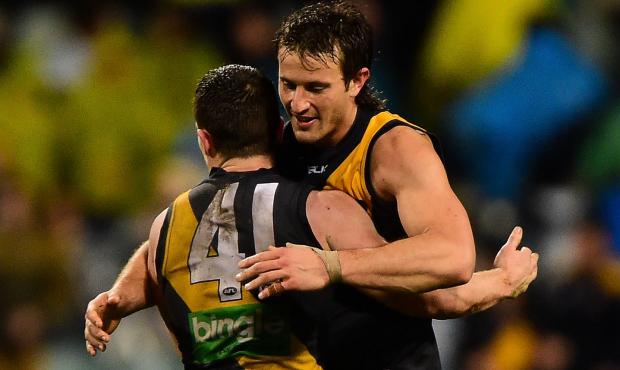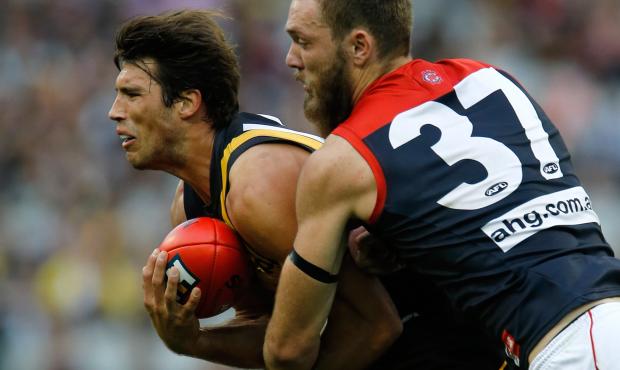ANYONE under any illusions as to the difficulty of going from rock bottom to AFL contender need only be reminded of Richmond's 2014 season.
When the club's impressive linear rise faltered, Tigers coach Damien Hardwick invoked the Pareto principle – or the law of the vital few – to explain why.
The loss of Brett Deledio, Ivan Maric and Alex Rance to injury – three of Richmond's six most important players – hurt.
Then, later, when that trio's return did not have an immediate impact on Richmond's win-loss record, Hardwick said the downturn was a case of his best players not playing well.
The comments raised some eyebrows but Hardwick was right on both counts.
The Tigers' 'metres gained differential' increased by 460 metres with Deledio in the team.
Their capacity to score from clearances increased 14 points a game with Maric in the team.
Opponents went from scoring from 50.8 per cent of entries into Richmond's forward 50 to just 46.6 per cent after Rance returned.
What Hardwick couldn't explain in a sound bite is the cumulative effect injuries have on clubs with skinny depth such as Richmond.
With the injuries to Dan Jackson and David Astbury added to the mix, the Tigers' negative spiral continued.
Clubs such as Richmond, or Port Adelaide – which has struggled since losing Alipate Carlile and Jackson Trengove in defence – rely on having their key players fit and firing at this stage of their list rebuilds.
If they're not, these clubs find themselves in trouble because role players or youngsters find it hard to get the job done in the absence of the stars.
Observers look at Hawthorn's ability to carry on without skipping a beat despite injuries to key players and wonder how Hardwick's logic holds up.
But the Hawks have established depth over time with patience, smart coaching and recruiting, and a good relationship with the Box Hill Hawks. Taylor Duryea, Mitch Hallahan, Alex Woodward, Angus Litherland and Will Langford have all stepped in at times this season after long apprenticeships in the VFL.
Richmond has not had that luxury with its players and has been forced to include quality whenever it came through the front door.
But as each year passes, Richmond's list becomes deeper and richer in quality and more players can step up when others miss.
Dustin Martin has been very good in 2014 and Richmond has unearthed another good player in Anthony Miles, who has played in five wins from eight games this season.
Brandon Ellis and Reece Conca have now been around long enough to play at a consistently high standard. Nick Vlastuin and Ben Lennon have shown their quality but will need a couple of more years in the system to turn matches.
 Ivan Maric has been a huge part of Richmond's late-season revival. Picture: AFL Media
Ivan Maric has been a huge part of Richmond's late-season revival. Picture: AFL Media
The good news for Tiger fans is that their club held firm at the selection table even when under pressure, only playing players when form demanded and young players when they were ready.
That's because it has the pyramid of power right with a quality president, CEO and football manager who support the coach.
They held their nerve and the ship has righted since round 15.
In that time Richmond has remained undefeated and its numbers have made better reading.
Most importantly, the club has admitted publicly that the downturn reminded its developing players of the standard at which they need to train to maintain pace with - let alone catch - the AFL's pacesetters.
Some have been critical of Tigers players for not recognising that earlier but those people overlook the reality that Richmond was a club devoid of finals experience until last season.
Even Hawthorn has had its moments of immaturity, losing a winnable final in 2007 and dropping off post-premiership in 2009. The club just stuck to its beliefs and kept getting better.
Since round 15, the Tigers have gone from No.11 in the AFL in the 'scores from clearances differential' category, to No.2 across the past five games. They have gone from being No.12 in the 'points from intercepts differential' to being No.4. All were strengths at the Tigers in 2013.
Richmond has also gone from being ranked 11th in 'contested ball differential' between rounds one and round 14 (-0.2) to being ranked first (+25).
Alex Rance's return has strengthened Richmond's defence significantly. Picture: AFL Media
Inside midfielder Miles is one identifiable reason but without the presence of outside runners Deledio and Nathan Foley (who has been in the team since round nine), the former Giant would be less effective.
Richmond knows it's not out of the woods. The club's third quarters remain a mysterious, unsolved problem as the Tigers are still being outscored in the premiership quarter and for some reason, they can't sustain their contested ball count.
The coaches have learned that not every problem can be solved at once, and that quality must be still be added to the list.
They also know there is no excuse for not giving Essendon one hell of a fright at the MCG on Friday night.
That Richmond remains in the hunt for the top eight is credit both to its resilience under pressure, and to the promise the club made to its players not so long ago.
That Richmond would not dwell on why things go wrong but understand how things go right, and keep the faith to make sure that even adversity provides opportunity for growth.
Richmond has won five in a row. The Tiger fans are yapping again. The long journey has reached another exciting juncture.
RICHMOND'S MISSING LINKS
| IVAN MARIC | Clearance to score % | Points from clearances difference |
|---|
| Played R11-19 | 23.9 | +42 |
| Absent R1-10 | 22.3 | +28 |
| ALEX RANCE | Opposition score per inside 50 | Points against |
|---|
| Played R1, R7-19 | 46.6 | 78.8 |
| Absent R2-6 | 50.8 | 95.5 |
| BRETT DELEDIO | Metres gained difference | Uncontested poss. difference |
|---|
| Played 1-2, 7-19 | +163m per game | +24 |
| Absent 3-6 | -297m per game | -12.5 |
Stats provided by Champion Data
 Ivan Maric has been a huge part of Richmond's late-season revival. Picture: AFL Media
Ivan Maric has been a huge part of Richmond's late-season revival. Picture: AFL Media


